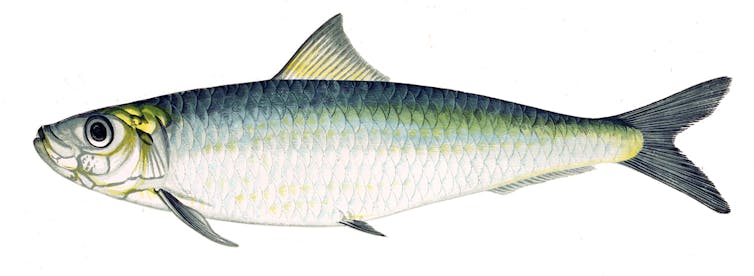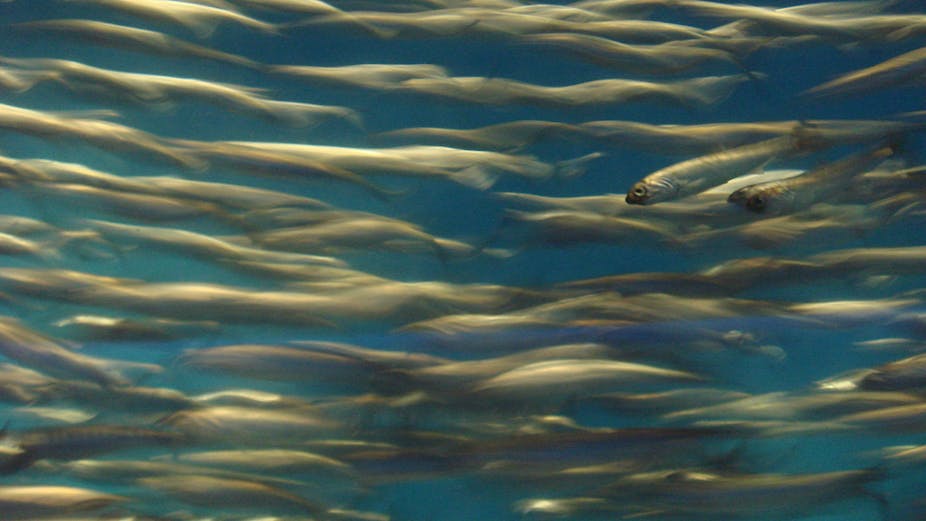Imagine setting up mirrors in a circle around you, the shiny sides all facing outwards to reflect your surroundings. To the casual observer you would appear to be “invisible”, blending into the environment around you.
Fish have developed this ability over millions of years of evolution, embodied in their shiny scales.
And now, a new study – published on Monday in Nature Photonics – suggests this natural ability in small silver fish (including sardines and herrings) could be harnessed to develop next-generation optical devices including light-emitting diodes (LEDs) and optical fibres.
A nifty ability
Reflective scales make a fish highly visible when it’s lying on a market stall ready to be sold – that is, when it’s out of its natural environment. But in water, highly reflective scales help fish to hide rather to be visible.
How?
When light passes through a medium such as air or water, it is reflected and scattered many times. This happens when the light comes into contact with something as tiny as a water molecule or with a larger molecule or object within the environment.
As a result of this scattering, light acquires a preferential polarisation – that is, the electric field of the light wave begins to be oriented as light travels in a certain direction.

If “polarisation” sounds familiar that’s because it’s a phenomenon that’s often used to help make our everyday lives easier. It’s used in sunglasses to suppress reflective glares, usually from a body of water or from a wet road. Computer monitors also emit polarised light but our eyes are not sensitive to it.
Light and depth mean life or death
For sea dwellers, having vision that’s sensitive to polarised light can be the difference between life or death – i.e. finding food or going hungry.
Why?
Sea creatures, especially those who live in the shallows have developed vision with natural “polarising glasses”. This polarised vision allows them not only to filter out reflected glare coming from the surface of the water, but also to see objects (such as food or a mate) since reflection acquires preferential polarisation at certain angles.
But many sea creatures haven’t just evolved the ability to see polarised light. As touched on above, they’re also able to reflect it in ways that can be extremely beneficial.
To be invisible in the shallows, a fish needs to reflect all polarisations of light equally at any angle of observation and at different wavelengths. In essence, the crystalline structure of a fish’s scales removes the polarisation from light before reflecting it back into the environment.

Crystal layers
The layered structure of fish scales has been known since the mid-1960s. Only now, with the new study in Nature Photonics, have we learned about the mechanism which gives fish scales their high reflectivity at all polarisations and for light travelling in all directions.
The key is the “birefringence” of the layers which form scales – that is, the fact the scales bend light more or less depending on the polarisation of the light coming in.
The authors of the Nature Photonics article, led by Tom Jordan from the University of Bristol, found that the skin of silvery fish contains two types of guanine crystal. These two types of crystal combine to ensure light reflected from the fish’s scales is not polarised.
Importantly, the multiple-crystal structure means the fish’s scales reflect light from all angles, meaning they appear virtually invisible to predators.
Inspired by nature
Not only are nature’s solutions in vision adaptation, camouflage and the reflectivity of surfaces amazing, they also have a range of potential applications when it comes to designing synthetic optical devices.
As part of their study, Jordan and colleagues advanced nature’s design a step further. They calculated a scale structure that would make fish almost entirely invisible – due to the 100% reflection of light from the surrounding ocean.

By using this optimised scale structure of non-polarising reflectors – which are functional at a wide range of angles – the work of Jordan and colleagues could lead to the development of more effective solar panels and solid-state lighting applications based on LEDs.
How?
Reflectivity – which is insensitive to the angle at which the light comes in – can be used in solar cells to efficiently harvest light without solar tracking systems.
In LED-based lighting devices, light extraction and the ability to avoid total internal reflection (i.e. light being trapped inside the device) allow greater output power.
Importantly, the method employed by Jordan and colleagues is different from other methods of controlled reflection using photonic crystals.
Existing photonic crystals can reflect light in all directions for certain wavelengths of light, but have to be made from materials such as diamond, titania or sapphire. The non-polarising reflector simulated by Jordan and colleagues is a simpler solution.
Just as fish and other animals continue to evolve over time, so too have the materials and technologies we’ve developed, inspired by such animals.

